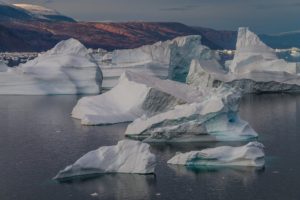Plastic Found in the Arctic Ocean Likely from Washing Clothes
- NPG
- January 27, 2021
- NPG Commentary
- 0 Comments
January 28, 2021
Plastic Found in the Arctic Ocean Likely from Washing Clothes
Cloud of Plastic in Oceans Reignite Concerns on the Overall Effects of Microplastics

The Arctic Ocean is filling with plastic. Microplastic fibers from clothes have made their way to the Arctic Ocean. Peter Ross, from the Ocean Wise Conservation Association in Canada, who led the most recent study, stated: “We’re looking at a dominance of Atlantic input, which means sources of textile fibers in the North Atlantic from Europe and North America are likely to be driving the contamination in the Arctic Ocean. With these polyester fibers, we’ve essentially created a cloud throughout the world’s oceans.”
An article explains how the microplastics landed in our oceans, sharing: “These tiny synthetic fibers can enter the water supply in wastewater from factories or from people washing their clothes. Wastewater treatment plants are able to catch much of it, but the rest can eventually flow into rivers, waterways, and ultimately, the ocean.”
Recent studies have shown:
- 96 of 97 seawater samples taken from across the polar region contained microplastic (Most of the samples were taken from 3-8 meters below the surface, where much marine life feeds.)
- 3,500 tons plastic microfibers from clothes washing in the US and Canada ended up in the sea each year (That’s equivalent to the weight of 3,043 small cars!)
- Plastic dumped in the seas around the UK was carried to the Arctic within two years
Microplastic has been found in the deepest and highest points on Earth. It is also known that people consume plastic in food and water and even breathe it in. But what we do not know are the health implications of ingesting microplastics. A CNN article explains the situation further, stating: “There are concerns around how these polyester fibers may impact humans and marine wildlife such as birds, fish, and zooplankton. Studies have already found microplastics in the guts of fish and sea life, and there are fears about the potential for human ingestion and possible health effects – especially for indigenous communities that rely heavily on seafood. Though the science on the impacts of microplastics on health is still nascent, Ross said we can be ‘fairly confident that plastic is not good for any creature of any size or shape of feeding ecology, and that plastic offers zero nutrition.’”
Although we cannot simply stop washing our clothing, there are other ways we can curb this onslaught of microplastics. We can recycle to keep plastics out of landfills, we can reduce the amount of single-use plastic we use, and we can choose to purchase clothing made with 100% natural fiber, like cotton. NPG believes protecting the environment is the key to ensuring a livable world for generations to come. Making a conscious decision to slow, halt, and eventually reverse population growth is the single best thing we can do to protect our planet for generations to come.
To read more about the environment and other population issues, please see our Forum paper series, notably:
Climate Change, Migration and National Security, by Edwin S. Rubenstein
The True Environmental Disaster – The Silence on Our Growing Overpopulation, by Michael G. Hanauer
